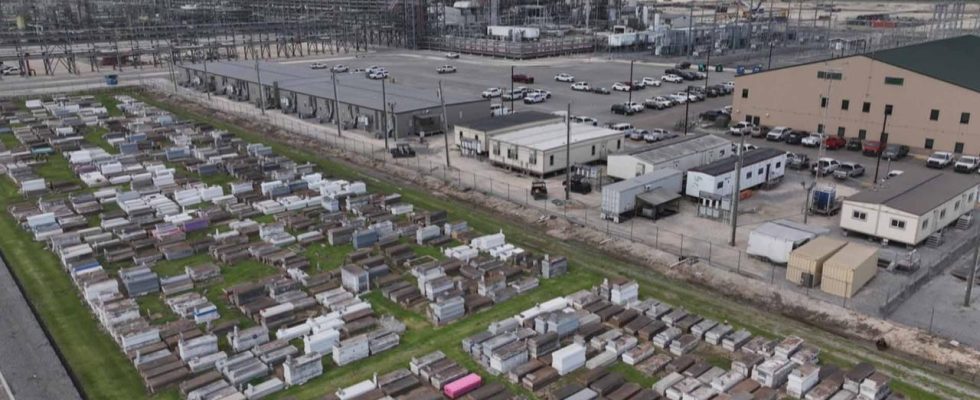world mirror
In “Cancer Alley” on the Mississippi, more than 130 kilometers of chemical works are lined up with refineries. There is hardly any place in the USA where the cancer rates are as high as here – especially among black people.
It’s not just grief Robert Taylor feels at his mother’s grave. He walks slowly through the cemetery. He keeps stopping, pointing to the tombstones. Here lie the dead of his community – many died of cancer. Like his mother, he says.
When he talks about cancer, he gets angry. Then his soft voice suddenly becomes loud. “We’re just being sacrificed here,” he says. Taylor blames the industry for the many cancer patients and deaths.
Elementary school near the factory
Factories enclose the cemetery from three sides except for a few meters. Taylor says there is nothing he can do for the dead here. But the tombs aren’t the only place in close proximity to the industry. The primary school in his community is less than a mile from a chemical plant.
Chloroprene is produced here, which is required for the manufacture of neoprene, for example for diving suits. A few years ago, the US Environmental Protection Agency classified chloroprene as a highly carcinogenic substance. Children are particularly at risk.
Earlier this year, she filed a lawsuit against the operator of the chemical plant. The chloroprene emissions represent a significant risk to public health. The operator disagrees. Adhere to applicable laws and regulations.
Robert Taylor is particularly committed to having this school closed in his community. The children are exposed to high concentrations of toxins from the industry.
130 km long “Cancer Alley”
The so-called “Cancer Alley” stretches a little more than 130 kilometers along the Mississippi. Chemical plants line this part of the riverbank in the US state of Louisiana with refineries.
The industry brings jobs and tax revenue – that’s how some see it. But: According to state information, the air is as bad as in Louisiana in hardly any other state – and the cancer rate is so high. A price that no longer everyone wants to pay on “Cancer Alley”.
Black neighborhoods particularly affected
It is above all the children for whom the activist Taylor fights with his initiative. For him, it is no coincidence that there are many factories in his community. Over 50 percent of the residents here are black. “We’re the easiest victims,” he explains. “This is blatant racism.”
Kimberly Terrell has researched this allegation. She is a researcher at Tulane University in New Orleans, about an hour’s drive from Taylor’s community. In all communities in Louisiana, she examined how cancer rates are related to air pollution and what role, for example, poverty or skin color play.
In comparison, unusually high cancer rates have in the areas with high air pollution, especially “People of Color”, i.e. non-white people, and low-income population groups.
Of course, black people aren’t the only ones affected by air pollution. However, the study showed that the closer people lived to the industrial plants, the higher the health risk. Industry has settled particularly strongly in the immediate vicinity of areas inhabited primarily by blacks.
The closer people live to the industrial plants in Louisiana’s “Cancer Alley”, the higher the health risk. Areas inhabited predominantly by black people are particularly affected.
“Politicians don’t trust residents”
Together with lawyers, she supports other small initiatives along the Mississippi with their lawsuits, for example against state institutions. From her point of view, the answer to the question of why the reports of the residents about the many cancer cases were not believed earlier is simple: politicians often trusted scientific studies in their decisions.
Reports by residents are less often trusted as evidence of a structural problem. This makes it difficult for those affected. When someone says there is no evidence of a health problem, their next question as a scientist is: has anyone done any research on this? In Louisiana, the answer is often: “No!”. This is one of the reasons why she carried out her study.
Hoping for the US government
Robert Taylor’s message now appears to have reached Washington. It’s a hot day in the capital. The Louisiana man stands in the shade of a tree in the Rose Garden of the White House. He is invited along with other activists. President Joe Biden wants to make it clear that environmental protection is his priority.
He promises Taylor and the others that they see the danger posed by polluted air and that the government wants to involve them. Finally feeling like the government is listening makes this day historic, Taylor says.
But he also says: He will measure deeds, not words. He wants to keep fighting – until the children in his neighborhood can safely go to school without a doubt.

